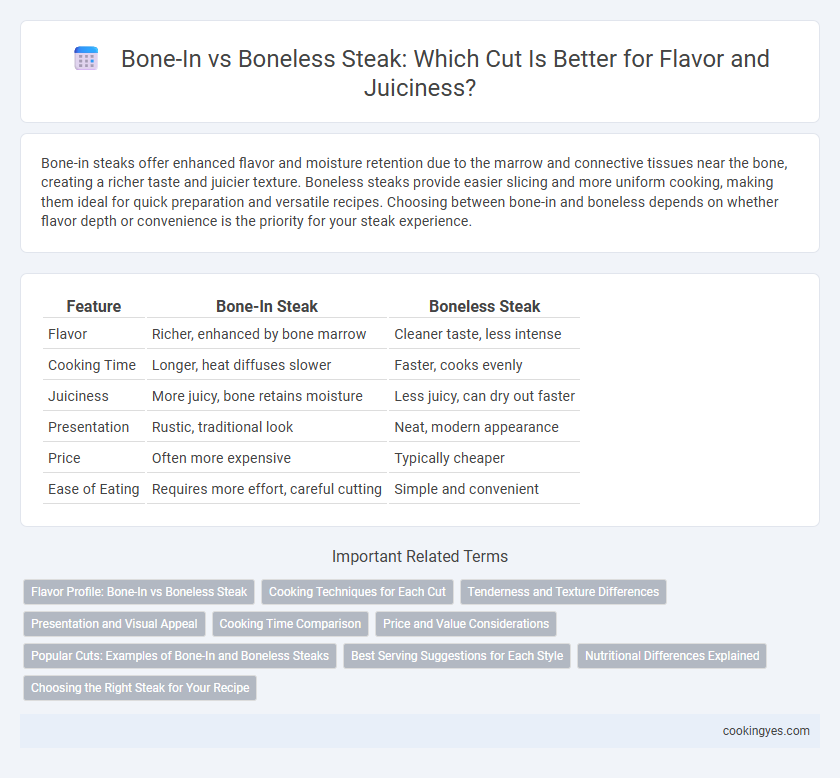Bone-in steaks offer enhanced flavor and moisture retention due to the marrow and connective tissues near the bone, creating a richer taste and juicier texture. Boneless steaks provide easier slicing and more uniform cooking, making them ideal for quick preparation and versatile recipes. Choosing between bone-in and boneless depends on whether flavor depth or convenience is the priority for your steak experience.
Table of Comparison
| Feature | Bone-In Steak | Boneless Steak |
|---|---|---|
| Flavor | Richer, enhanced by bone marrow | Cleaner taste, less intense |
| Cooking Time | Longer, heat diffuses slower | Faster, cooks evenly |
| Juiciness | More juicy, bone retains moisture | Less juicy, can dry out faster |
| Presentation | Rustic, traditional look | Neat, modern appearance |
| Price | Often more expensive | Typically cheaper |
| Ease of Eating | Requires more effort, careful cutting | Simple and convenient |
Flavor Profile: Bone-In vs Boneless Steak
Bone-in steaks typically offer a richer, more intense flavor due to the marrow and collagen within the bone, which slowly infuses into the meat during cooking. Boneless steaks provide a cleaner, more uniform texture and flavor, allowing seasonings and marinades to penetrate more evenly. The presence of the bone in bone-in cuts also helps retain moisture, resulting in a juicier and more robust taste.
Cooking Techniques for Each Cut
Bone-in steaks retain heat longer, allowing for more even cooking and enhanced flavor through marrow infusion, ideal for grilling or pan-searing with moderate heat to prevent overcooking. Boneless steaks cook faster and more uniformly, making them suitable for high-heat methods like broiling or quick searing, enabling a perfect crust without the risk of uneven doneness. Adjusting cooking times and temperatures is crucial for each cut to maximize tenderness and juiciness, ensuring optimal steak texture and taste.
Tenderness and Texture Differences
Bone-in steaks often retain more moisture during cooking, resulting in a juicier and more tender texture due to the marrow and connective tissues surrounding the bone. Boneless steaks offer a more uniform texture and are easier to cook evenly, but may lack the depth of flavor and slight firmness provided by the bone. The presence of the bone can also affect heat distribution, subtly enhancing tenderness in cuts like ribeye or T-bone.
Presentation and Visual Appeal
Bone-in steaks showcase a rustic, hearty appearance that enhances visual appeal through the contrasting textures of meat and bone, making them ideal for premium presentation. The bone acts as a natural frame, emphasizing the steak's thickness and marbling, which can entice diners and elevate the dining experience. Boneless steaks offer a sleek, clean look that allows for precise plating and garnishing, appealing to those who prefer a modern, minimalist presentation style.
Cooking Time Comparison
Bone-in steaks require longer cooking times than boneless cuts due to the heat conduction difference caused by the bone, which slows heat penetration. The bone acts as an insulator, resulting in more even cooking but extended time to reach the desired internal temperature. Boneless steaks cook faster and more uniformly since heat can directly penetrate the meat without obstruction.
Price and Value Considerations
Bone-in steaks typically cost more due to the added weight of the bone and perceived flavor enhancement, offering better value for those prioritizing taste and presentation. Boneless steaks often provide a higher meat-to-price ratio, appealing to buyers seeking quantity and ease of cooking. Price differences vary by cut and region, with bone-in options favored in premium markets for their rich texture and visual appeal.
Popular Cuts: Examples of Bone-In and Boneless Steaks
Bone-in steaks like ribeye and T-bone deliver richer flavor and juicier texture due to the marrow and connective tissues near the bone. Boneless cuts such as filet mignon and strip steak provide ease of cooking and uniform thickness, making them popular for grilling and pan-searing. Choosing between bone-in and boneless depends on desired taste intensity and cooking method preferences.
Best Serving Suggestions for Each Style
Bone-in steaks, such as ribeye or T-bone, retain more moisture and flavor, making them ideal for grilling or roasting to enhance their rich, beefy taste; serve with herb butter or chimichurri to complement the savory profile. Boneless steaks like filet mignon or sirloin cook faster and evenly, perfect for pan-searing or sous vide preparation; pair with creamy sauces or caramelized onions to elevate tenderness and subtle flavor. Serving suggestions for each style consider cooking method and sauce pairing to maximize the steak's texture and taste experience.
Nutritional Differences Explained
Bone-in steaks often retain more minerals like calcium and phosphorus due to the marrow's proximity, enhancing overall nutrient density compared to boneless cuts. Boneless steaks typically have lower iron content but offer easier portion control and reduced cooking time, affecting protein retention. The presence of bone can also influence cooking methods that preserve B vitamins, making bone-in cuts potentially more nutritious.
Choosing the Right Steak for Your Recipe
Bone-in steaks deliver enhanced flavor and juiciness due to the marrow and connective tissues enriching the meat during cooking, ideal for slow grilling or roasting recipes. Boneless steaks offer convenience and even cooking, making them perfect for quick searing or stir-fry dishes where tenderness and speed are priorities. Selecting between bone-in and boneless depends on the desired cooking method and flavor intensity for your recipe.
Bone-In vs Boneless for Steak Infographic

 cookingyes.com
cookingyes.com